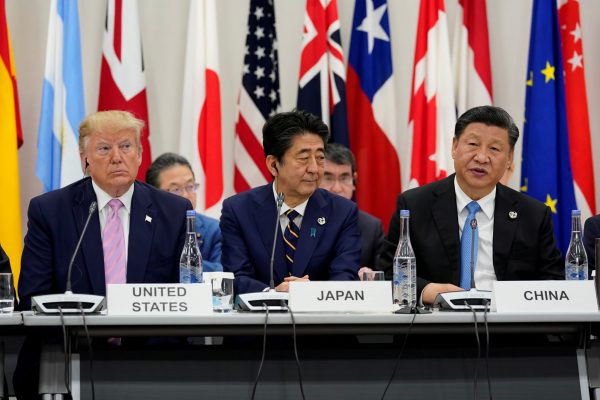Abe commenced his second term with an ambitious policy program focused on reinvigorating the nation’s stagnant economy, amending the constitution to achieve a more ‘normal’ defence and security policy, and engaging proactively in regional and global affairs.
In the latest issue of East Asia Forum Quarterly, launched today, scholars from both inside and outside Japan critically appraise Abe’s domestic and foreign policy programs.
To what extent has Abe brought his policy goals to fruition? How has he utilised the immense political capital accrued throughout his leadership tenure? And what will be the legacy that Abe leaves when his prime ministership ultimately comes to an end?
EAFQ also examines the array of challenges that Abe will have to grapple with in his third and final leadership term. Japan’s long-term alliance with the United States is becoming more transactional than strategic under the Trump administration. The problems of an ageing society and growing economic disparities demand active political innovation. The mercurial US President, Donald Trump, has initiated a trade war with China, undercutting the multilateral rules-based global trade regime on which Japan’s post-war prosperity and security have been founded. Trump’s initiatives on the Korean Peninsula have also undermined Abe’s hardline policy toward North Korea. Meanwhile, Japan’s relations with South Korea have now reached their lowest ebb in decades, and North Korea’s Kim Jong-un has resumed short-range missile testing.
On a more positive note, some challenges have become opportunities for a stronger leadership. Abe has taken a risk on immigration reform. Environmental issues have become new fields of leadership, while the Tokyo 2020 Olympic Games await. The ability of Abe to navigate the challenges and turn them into opportunities will not only determine his leadership legacy, but will also shape Japan’s prospects for peace and security and those of the region more broadly.
In this week’s lead article from EAFQ, Tobias Harris examines Abe’s pursuit of a tangible legacy. He argues that while Abe had some important political victories, he is ‘unlikely to achieve perhaps his most-cherished political goal, revising Japan’s post war constitution’. This is particularly so in light of the recent July 2019 upper house election results: Abe’s ruling bloc won a clear majority but failed to win a two-thirds supermajority to secure sufficient votes for constitutional reform. Harris says that Abe’s legacy appears ‘to be more of a cautionary tale about the limits of strong leadership in industrial democracies everywhere — particularly in the face of long-term, far-reaching problems’.
While Japan’s pacifist constitution may be here to stay — at least in the foreseeable future — that should not obscure Abe’s success in other policy domains. Under his leadership, Japan has undoubtedly adopted a more global outlook, evidenced by a greater receptiveness to foreign goods, capital, workers, tourists, and ideas. Abe’s wide-reaching diplomacy has also helped to deepen Japan’s ties with strategic partners in Asia and Europe.
Abe has furthermore boosted Japan’s stature in global and regional trade policymaking. Spurred by Trump’s withdrawal from the Trans-Pacific Partnership (TPP) in 2017, Abe transformed Japan’s role from a passive bystander in trade policy developments to a leader of the TPP bloc. He has also managed simultaneously to strengthen bilateral ties with the United States and build a more stable partnership with China — a diplomatic tightrope that few world leaders have walked so well.
Although Abe has emphasised the success of his economic policies — so-called Abenomics — these policies have yet to improve the outlook for the nation’s demographic crisis. And despite having launched a diplomatic charm offensive toward Russia, entailing many significant concessions on Tokyo’s part, Abe has failed to resolve the two countries’ long-standing territorial dispute.
As Harris surmises, Abe’s approach to his most coveted policy goals has been marked by caution, and his expectations have been adjusted and tempered on the grounds of feasibility and pragmatism. ‘This leadership style has ensured that he survived long enough to set new endurance records, but it may not be sufficient to stave off Japan’s long-term decline in a rapidly changing Asia’.
Ben Ascione and Yuma Osaki consider the prospects of leadership in the post-Abe era. They argue that Japan’s complex policy challenges demand fresh political vision and statesmanship to yield innovative responses. In particular, there is a need for ‘deeper structural economic reforms — beyond the mantra of Abenomics — to boost productivity and manage the burgeoning national debt as society ages and the tax base shrinks’. Another key policy challenge is the diplomatic management of Japan’s volatile relations with its regional neighbours.
Unfortunately, however, there remain a number of institutional barriers to the emergence of fresh leadership in Japan. These include the unusually high proportion of dynastic politicians, the weak state of opposition parties and widespread political apathy, and also limited opportunities for female politicians. The rise in popularity of LDP member Shinjiro Koizumi, the son of former prime minister Junichiro Koizumi, can partly be explained by the Japanese preference for dynastic politicians. This rising political star promises a balance between the LDP brand’s stability and maverick reform in the image of his father.
Ascione and Osaki conclude that there is some room for optimism that innovative leadership could emerge in Japan. Yet in order for this to happen, ‘significant changes are needed to promote greater meritocracy within the LDP, to rebuild credible opposition parties that can hold the government accountable and provide platforms for leadership, and to advance the participation of women in Japan’s political leadership’.
The EAF Editorial Board is located in the Crawford School of Public Policy, College of Asia and the Pacific, The Australian National University.

